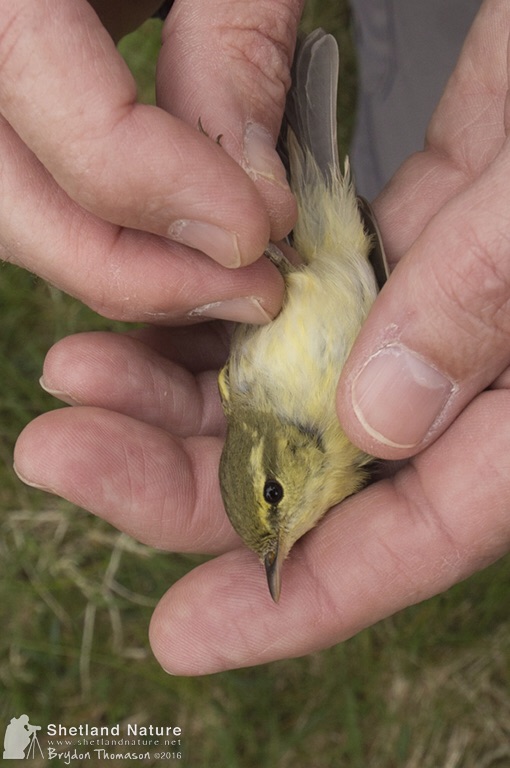Thursday 12 May had seen a slow trickle of scarce migrants turn up on Unst, Shetland, including Wryneck, Bluethroat and Red-backed Shrike. I couldn't get out until after 6pm, and decided to look for the male Bluethroat at Haroldswick. There, I met Unst's newest resident birder, Dave Cooper (DC), who told me he had just seen a Red-backed Shrike at Setter Hill Estate (SHE) in Baltasound. As this was on my way home I decided to have a look for it before it got too late.
When I arrived at SHE I flushed a Phylloscopus warbler. My first impression was that it was bright enough to be a Wood Warbler, but as soon as it landed I knew that it wasn't, although it was certainly a bright bird. Then I noticed the obvious wing-bar; confusion ensued. Obviously, Arctic and Greenish Warblers were the first candidates for consideration, but neither of these seemed likely; the structure was certainly wrong for Arctic and the bird looked nothing like the Greenish I had seen on Unst the previous spring. What else has wing-bars? Yellow-browed? Obviously, no, as the tertials were plain; but was that just the hint of a second wing-bar? Two quick views and the bird had gone. I'd left my camera in the car as the light was already going, but I decided to get the camera and try and relocate it. I found it again, but only had flight views (it was bright enough to be distinctive) and it seemed to be intent on going to roost, so I decided to leave it and hope it was there in the morning.
I immediately went round to see Brydon Thomason (BHT) to tell him what I had seen: a bright Phyllosc with a yellow face and a wing-bar, which, as far as I could work out, had to be a Willow Warbler with a bold wing-bar (unlikely, surely?) or a Green Warbler (equally unlikely?).
We arranged to meet up at the site at 7 am the next morning (13 May), when we were joined by Rob Brookes (RJB) and DC. It took a while to relocate the bird, as it had moved from the main pine plantation to a small patch of low bushes were it was quite hard to observe. BHT obtained a few photos though, and at least one showed a pale line above the bill. We assumed that this meant that the supercilia met above the bill, said to be a character of Greenish Warbler, but not Green. We kept watching for a while, frequently commenting on how bright the bird was, but when it flew to another patch of bushes we left.
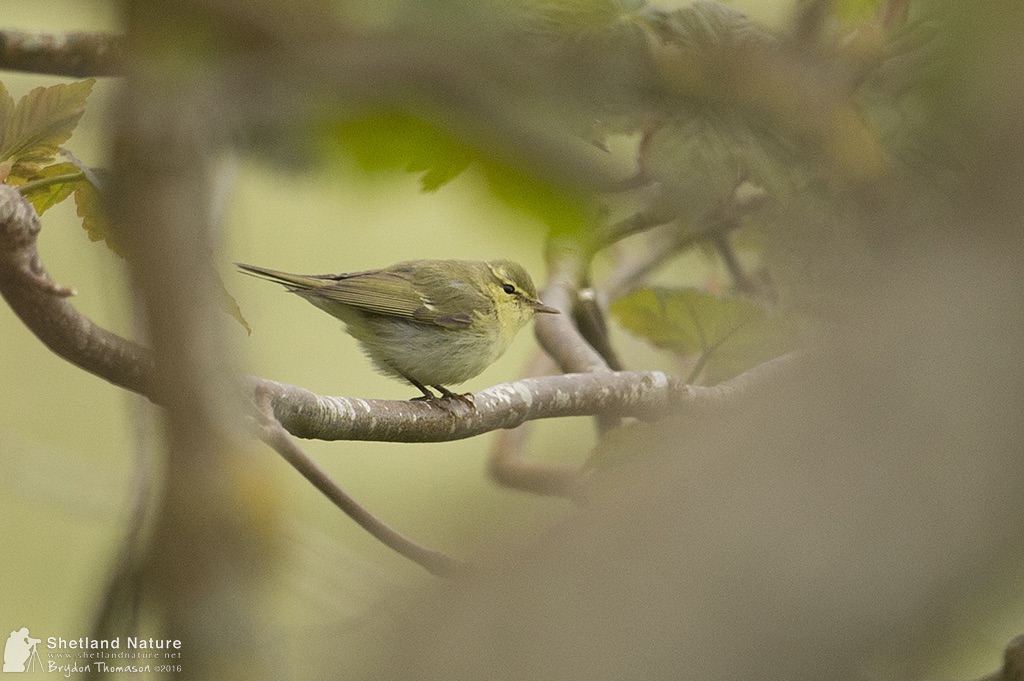
Green Warbler, Baltasound, Unst, 14 May 2016 (Photo: Brydon Thomason)
Before heading to work I decided to put out news on the local MDS service, then looked for a few photos on the internet. I wanted to see just how bright a Greenish could be in spring — the only one I'd seen before had been very dull. I found photos of the Finnish Green Warbler from 2012, initially thought to be a very bright Greenish, and stopped in my tracks. The resemblance to our bird was striking — and several photos showed an obvious pale line above the bill. It would appear that we had jumped to conclusions too soon. I phoned BHT, who was going through the same thought process, had been looking at the very same photos and was having the same doubts. While I had to go to work, BHT and DC set out to relocate the bird.
It was after three in the afternoon before they found it, as it had moved to the sycamore plantation at Halligarth, although only a few hundred metres away from where it has been found. At least one of the four of us (myself, BHT, DC, RJB) were with it until it went dark. As it was dull and overcast, and the bird was feeding above our heads most of the time, it was difficult to assess just how bright it was. In these conditions, it often looked quite dull, and doubts set in again. But then we would see it lower down, against a dark background, and it would suddenly look very different. But, with no single diagnostic feature, we were left in a dilemma. Myself, BHT and DC agreed, the combination of features looked very good for Green, but we had heard no calls and had no DNA.
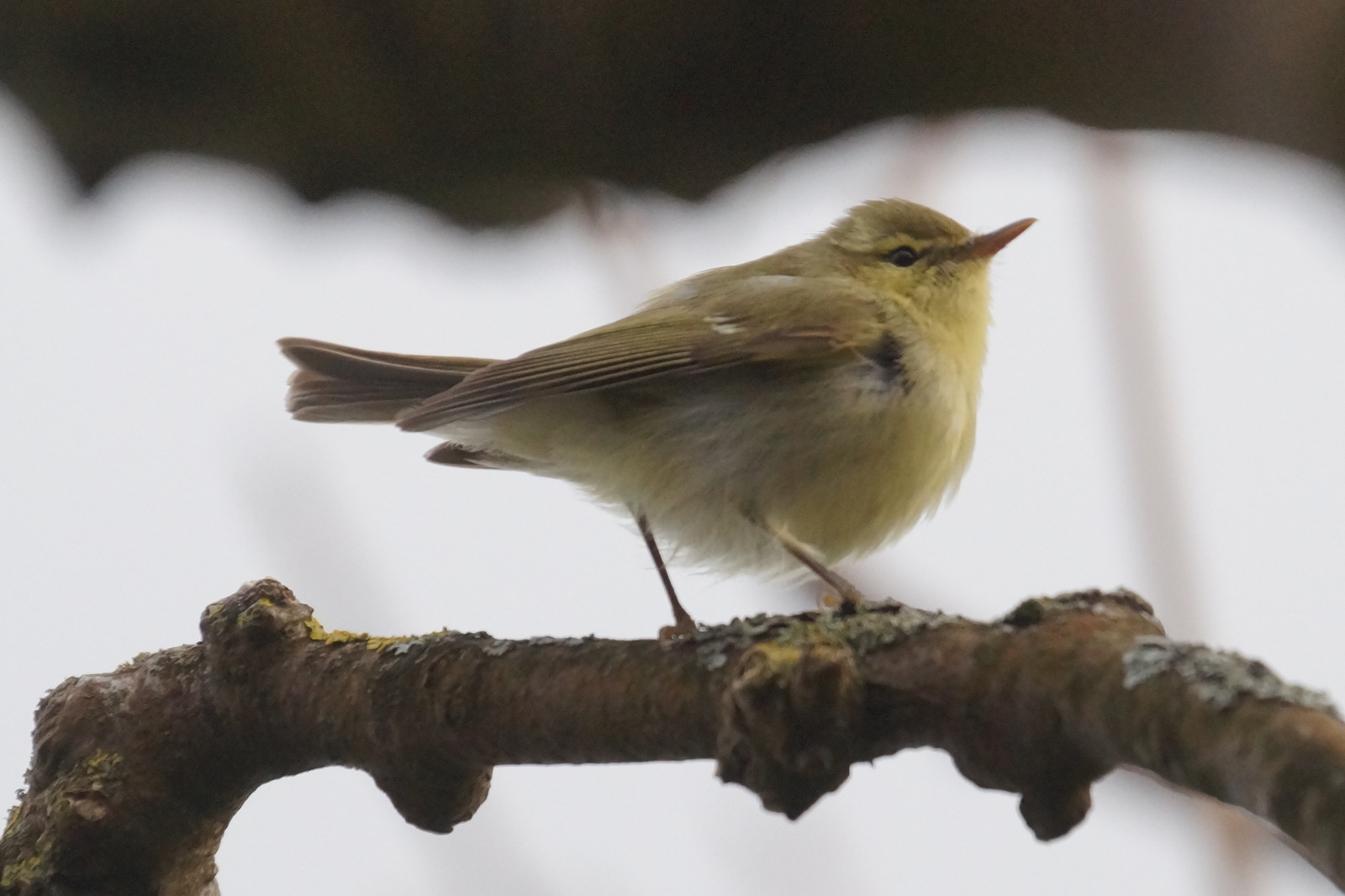
Against a grey sky the bird appeared somewhat duller (Photo: Mike Pennington)
We were left with a difficult decision. If we put out any news and people travelled for it before it was clinched, then there might be some unhappy people if we were wrong. But if we didn't put out some news, and people didn't see it, there would also be some unhappy people. We phoned a few people that evening and circulated a few photos. Responses were understandably cautious, but also encouraging. We obviously needed fresh eyes on the bird.
The next morning the bird was still at Halligarth at 7am, but then it disappeared. We decided to widen the search once Roger Riddington (RR) had arrived from Shetland Mainland and headed back to SHE, where we saw the bird almost immediately. With the bird low down against a dark background, it looked very bright, and RR's reaction was "wow, that's amazing! If I was you, I'd put news out!" This was all the encouragement we needed.
A little later the bird was trapped in a mistnet erected in one the existing net rides at the site. As soon as we saw it in the hand any lingering doubts disappeared. It was a striking bird. The bird was ringed and processed by myself, RR and Will Miles, and DNA samples were obtained in the form of a faecal sample and accidentally shed feathers. After photographs were taken, microphones were readied in case it called upon release. It didn't; it remained stubbornly silent throughout its stay.
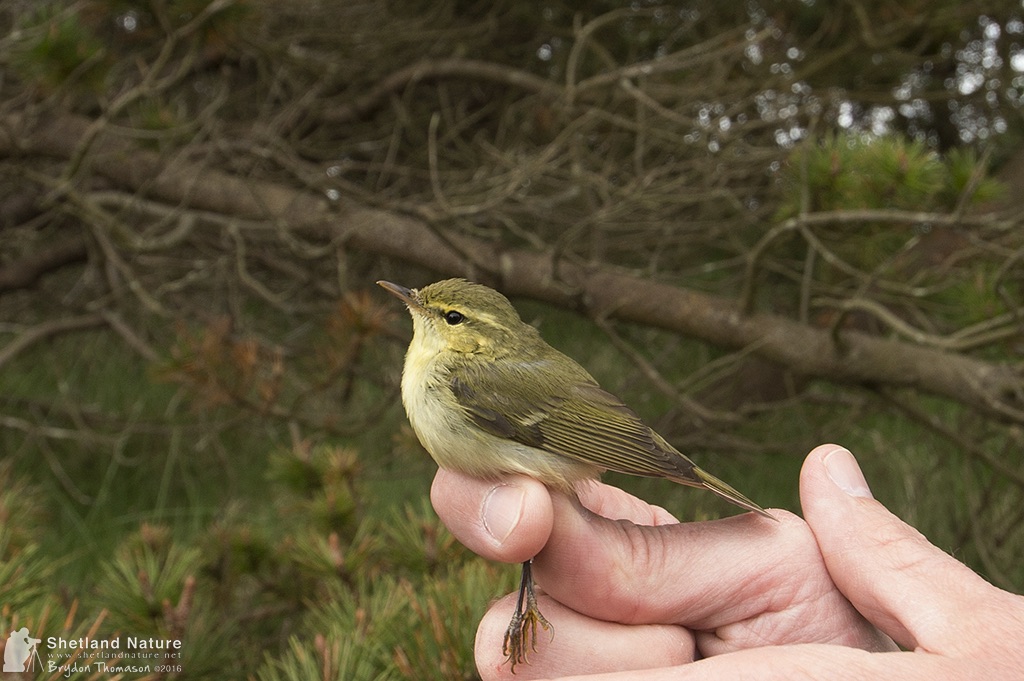
Photos of the bird in the hand, illustrating the strong yellowish wash to the underparts and overall bright plumage, superficially resembling Wood Warbler (Photos: Brydon Thomason)
About 20 people saw the bird on the Saturday afternoon and, on the Sunday (15 May), despite being elusive early on, the bird was found at SHE mid-morning and remained all day. More birders arrived, including some from further afield. Only two charter planes made it in (it was, apparently, a busy horse-racing weekend with planes booked to transport jockeys between race courses), but others arrived by a combination of scheduled airlines and hire car. On Monday 16 May there was one report of a brief sighting in the afternoon, but there were others searching all day without success.
Identification of Green Warbler is, obviously, not straightforward. Most plumage characters overlap, so most of the references we looked at it were full of phrases like '… a tendency to be ...' and '… usually more …'. Overall, though, there does seem to be a combination of characters which are unique.
The brightness of the plumage is what caught my eye first, and the superficial initial resemblance to the colours of Wood Warbler. The plumage varied considerably according to the light, and sometimes the bird looked quite dull, but the upperparts and wing-fringes were brighter green than even the brightest Willow Warbler. The underparts were all yellow, especially so in the hand, although in the field it sometimes only looked as though the face and throat were yellow. In the hand, it could be seen that the whitest part was the flanks. This maybe helped contribute to the occasional impression in the field that only the face was yellow.
The supercilium caused us some problems, but was distinctive. It was distinctly yellow, brightest in front of the eye. In many photos it looks it quite clearly stops short of the bill, but there were pale bristly feathers above the bill which, at some angles, made it look as though the supercilia met above the bill. The problem of defining the exact position of the supercilia is a pitfall that has been discussed before in the context of some controversial records of Greenish and Arctic Warblers. It is worth noting the Finnish Green Warbler from 2012 seems to have the supercilia meeting above the bill in some photos. Obviously, the value of this character is limited.
The wing-bar was very distinct: broad, chunky, square-ended and more or less white, without the obvious yellow of the underparts. A very indistinct second wing-bar was visible at times, in the field as well as in photos, but it was often obscured by other feathers.
Structurally, biometrics proved nothing as none are diagnostic, but several measurements appear to be better for Green, and the bird had a long wing-length (67 mm) towards the upper limit for both species. In the field, it looked quite long-winged and large-billed, but whether these were significant differences are debatable.
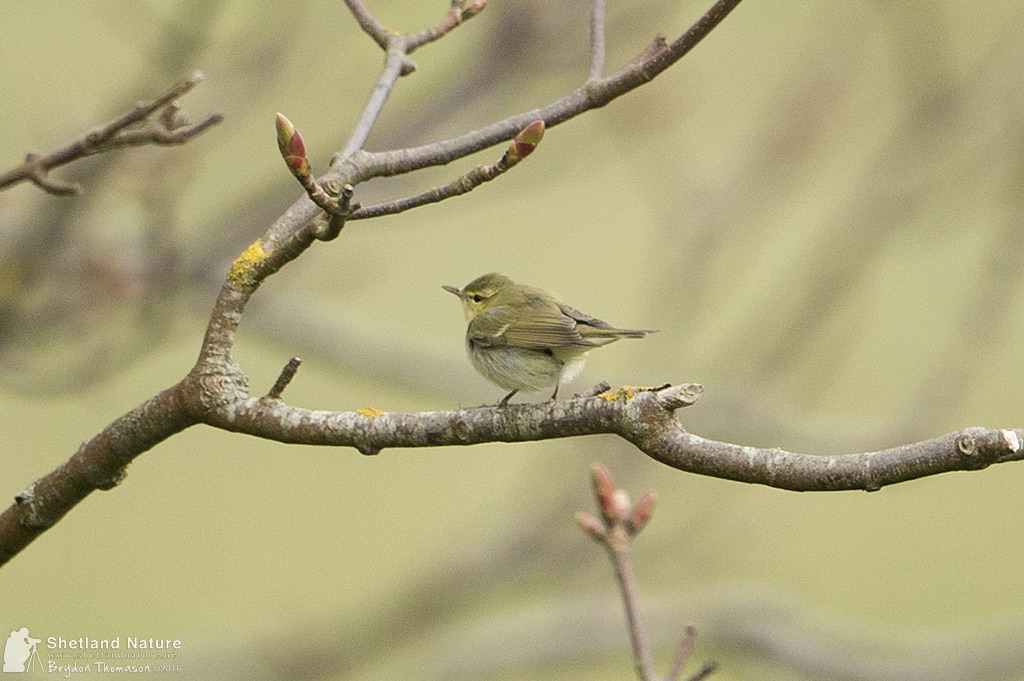
Green Warbler, Baltasound, Unst, 14 May 2016 (Photo: Brydon Thomason)
Our DNA samples were sent away by Special Delivery on Monday and Martin Collinson pulled out all the stops to get the analysis done. It was maybe not great surprise, but it was certainly a relief, when the results came through, less than a week after the bird was trapped. The sequence for the Baltasound bird was virtually identical to two other previously sequenced Green Warblers, and was 3-5 per cent different from other taxa in the Greenish Warbler group.
There appear to be eight previous accepted records in Europe, as well as another three widely published records which have not been accepted by the relevant committees. In NW Europe, only the first two records, on Helgoland and Scilly, have been in autumn. The subsequent records have been in spring, with the Shetland bird the earliest so far, although only one has been as late as June. The Shetland bird also means there have now been three in the last five years in NW Europe. Several bright Greenish Warblers have been claimed as possible Green Warblers in Britain in the past, perhaps most notably a bird in Suffolk in 1993. If good quality photos exist of some of these birds, perhaps they should be re-examined.
Published European records of Green Warbler
| 1867 | Germany | Helgoland, shot, 11 October |
| 1983 | Britain | St Mary's, Scilly, first-winter, photographed, 26 September to 4 October |
| 1997 | Faroe Islands | trapped and DNA sample taken, 8 June |
| [Germany | Helgoland, 8 June] | |
| 1998 | [Germany | Helgoland, photographed, 1 June] |
| Greece | 18 September | |
| 2000 | Greece | 27 September |
| 2003 | Sweden | trapped and DNA sample taken, 29 May |
| [France | Pas-de-Calais, 21 May] | |
| 2012 | Finland | Lågskär, Åland Islands, photographed, 20 May |
| 2015 | Denmark | Blåvand, trapped and DNA sample taken, 27 May |
| 2016 | Britain | Baltasound, Shetland, trapped and DNA sample taken, 12-15 May |
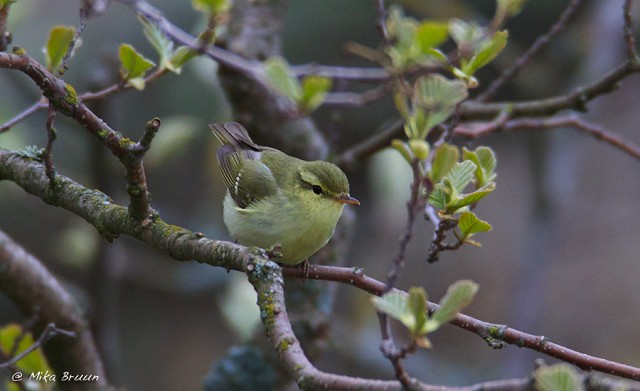
Green Warbler, Lågskär, Finland, 20 May 2012 (Photo: Mika Bruun)
Finally, we can't help but think of Martin Garner when a bird like this turns up. He would have loved it and would have been one of the first we would have turned to for advice. His 'anything can happen, never let it go' attitude made many birders try just a little bit harder, ourselves included.

